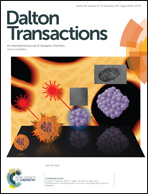Sequential structural transitions with distinct dielectric responses in a layered perovskite organic–inorganic hybrid material: [C4H9N]2[PbBr4]†
Abstract
A novel organic–inorganic hybrid layered perovskite-type compound of the general formula A2BX4, bis(IBA)tetrabromolead(II) (1, IBA = isobutyl-ammonium cation), has been successfully synthesized and grown as flake-like crystals, and undergoes two reversible solid-state phase transitions at 315 K and 250 K, and has been systematically characterized using differential scanning calorimetry measurements, variable-temperature structural analyses, variable-temperature powder X-ray diffraction measurements and dielectric measurements. 1 exhibits a remarkable temperature-dependent dielectric behavior, which could be switched between high and low dielectric states above room temperature, and a broad peak exists below room temperature. The most striking dielectric property is the remarkable anisotropy along the various crystallographic axes. All of these demonstrate its potential application as a high temperature switchable molecular dielectric and low temperature phase transition material.
![Graphical abstract: Sequential structural transitions with distinct dielectric responses in a layered perovskite organic–inorganic hybrid material: [C4H9N]2[PbBr4]](/en/Image/Get?imageInfo.ImageType=GA&imageInfo.ImageIdentifier.ManuscriptID=C5DT03277F&imageInfo.ImageIdentifier.Year=2015)

 Please wait while we load your content...
Please wait while we load your content...